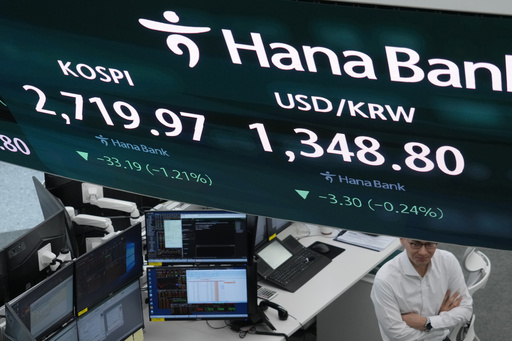TOKYO (AP) — Asian shares mostly declined Wednesday after Wall Street sank, hitting the brakes on what’s been a nearly unstoppable romp.
Japan’s benchmark Nikkei 225 slid 0.8% in morning trading to 39,511.88. Sydney’s S&P/ASX 200 slipped 1.3% to 7,788.20. South Korea’s Kospi dropped 1.3% to 2,716.65. Hong Kong’s Hang Seng lost 0.6% to 16,832.52, while the Shanghai Composite fell 0.3% to 3,066.66.
Analysts said worries were growing that what rattled Wall Street might spread to Asia, despite recent relatively positive economic signs from China.
“Investors are grappling with the possibility that this turbulence could mark the beginning of a more significant correction in the markets,” said Stephen Innes, managing partner at SPI Asset Management.
China has an ambitious target of around 5% economic growth this year, seeking to put behind recent troubles in the property sector and the lingering effects of the disruptions that came from the pandemic.
On Wall Street, the S&P 500 fell 37.96 points, or 0.7% to 5,205.81 for its worst day in four weeks. It was its second straight drop after setting an all-time high to close last week.
Other indexes did worse. The Dow Jones Industrial Average lost 396.61 points, or 1%, to 39,170.24 and likewise pulled further from its record. The Nasdaq composite fell 156.38, or 1%, to 16,240.45, and the small stocks in the Russell 2000 index tumbled 1.8%.
Health insurance companies led the market lower on worries about their upcoming profits after the U.S. government announced lower-than-expected rates for Medicare Advantage. Humana tumbled 13.4%. Tesla, meanwhile, dropped 4.9% after delivering fewer vehicles for the start of 2024 than analysts expected.
One of the big reasons the U.S. stock market has screamed higher since late October is the expectation that the Federal Reserve will cut interest rates several times this year. The central bank itself has hinted as much, and an easing of rates would relieve pressure on both the economy and financial system.
But Fed officials have also said they need further confirmation inflation is heading sustainably down to their 2% target before acting. A surprisingly strong report on U.S. manufacturing Monday, which showed a return to growth after 16 straight months of contraction, hurt those expectations.
It’s the latest evidence of a remarkably resilient U.S. economy. That keeps people employed and corporate profits humming, but it could also add upward pressure on inflation. Progress there has become bumpier recently, with inflation reports this year coming in hotter than expected.
Traders have already drastically reduced their expectations for how many times the Federal Reserve will cut interest rates this year, halving them from a forecast of six at the start of the year. That would be in line with the three cuts that Fed officials themselves have hinted at.
Because the U.S. economy has remained stronger than expected, investors say the chances are rising that the Fed may deliver just two rate cuts this year. Gargi Chadhuri, chief investment and portfolio strategist, Americas, at BlackRock, suggests investors keep their bets spread across a wide range of investments, rather than “trying to time the market – or the Fed.”
Loretta Mester, president of the Cleveland Fed, said Tuesday that the bigger risk is cutting interest rates too early, rather than too late. The former could allow the economy to overheat and inflation to reaccelerate, while the latter could cause unnecessary pain for workers.
Her comments came as economic reports showed U.S. employers were advertising roughly the same number of job openings in February as they were a month earlier and a stronger-than-expected gain in factory orders.
In the bond market, the yield on the 10-year Treasury rose to 4.35% from 4.33% late Monday.
The two-year yield, which moves more closely with expectations for Fed action, slipped to 4.69% from 4.71% late Monday.
High rates slow the economy by design, by making borrowing more expensive. They also hurt prices for investments by making it more attractive for investors to put money instead in safer alternatives. Bitcoin fell 5.4%.
Beyond worries about interest rates staying high, critics say the U.S. stock market has also simply grown too expensive after soaring more than 20% in six months. Companies will likely need to deliver strong growth in profits to justify such big moves.
In energy trading,
They followed the price of crude higher. A barrel of benchmark U.S. oil rose $1.44 to settle at $85.15 and is back to where it was in October. A barrel of Brent crude, the international standard, climbed $1.50 to $88.92.
In currency trading, the U.S. dollar rose to 151.56 Japanese yen from 151.54 yen. The euro cost $1.0075, little changed from $1.0776.
___
AP Business Writer Stan Choe contributed.
This website uses cookies so that we can provide you with the best user experience possible. Cookie information is stored in your browser and performs functions such as recognising you when you return to our website and helping our team to understand which sections of the website you find most interesting and useful.
